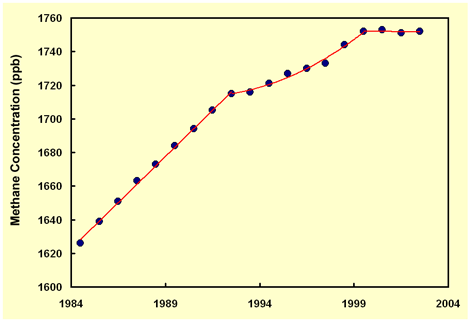Reference
Dlugokencky, E.J., Houweling, S., Bruhwiler, L., Masarie, K.A., Lang, P.M., Miller, J.B. and Tans, P.P. 2003. Geophysical Research Letters 30: 10.1029/2003GL018126.
Background
In our Editorial of 8 Jan 2003, we discuss the study of Simpson et al. (2002), who present global tropospheric methane (CH4) growth rate data for the years 1984-2000, and who do everything in their power to convince readers of their paper that there is not "a trend of declining CH4 growth." We, however, conclude that that is precisely what the data show; and we go on to suggest that although atmospheric CH4 concentrations may continue to rise for some time yet, it is very likely that in the not too distant future "we should be able to see an actual decline in the atmosphere's global CH4 concentration." In this Journal Review, we thus report the findings of the most recent study of this subject to see if the newest two years of measurements give any indication of who is more likely to be correct on this issue: we or Simpson et al. and the IPCC.
What was done
Based on measurements from 43 globally-distributed remote boundary-layer sites that were obtained by the methods of Dlugokencky et al. (1994), the authors defined an evenly-spaced matrix of surface CH4 mole fractions as a function of time and latitude, which they then used to calculate global CH4 concentration averages for the years 1984-2002.
What was learned
We have extracted the authors' results from their graphical presentation and re-plotted them as shown in the figure below, where it can be seen that they fall into three natural groupings: initial and latter stages, to which we have fit linear regressions, and an intervening middle stage, to which we have fit a second-order polynomial.

What it means
With Dlugokencky et al., we note that the globally-averaged atmospheric methane abundance "was constant at ~1751 ppb from 1999 through 2002," which suggests, in their words, that "during this 4-year period the global methane budget has been at steady state." They note, however, that "our understanding is still not sufficient to tell if the prolonged pause in CH4 increase is temporary or permanent." We agree. However, based upon the fact that the data describe an initial stage of significant yearly CH4 increase, a subsequent stage of much smaller yearly CH4 increase, and a latter stage of no yearly CH4 increase, we feel confident in suggesting, as we did in our review of Simpson et al.'s paper, that if the most recent prolonged pause in CH4 increase is indeed temporary, it will likely be followed by a period of decrease in CH4 concentration, as that would be the next logical step in the observed progression from significant, to much smaller to no yearly CH4 increase.
What is its significance?
Why is it important to have a proper knowledge of the likely future course of atmospheric methane concentration? It is important because, as Dulgokencky et al. report, "the increase in its atmospheric burden since 1800 had led to approximately half the estimated increase in global tropospheric ozone during this time (Prather et al., 2001)," as well as the fact that "atmospheric methane's contribution to anthropogenic climate forcing is about half that from CO2 when direct and indirect components to its forcing are summed (Hansen and Sato, 2001)." In addition, they note that "all CH4 emission scenarios considered by the IPCC Special Report on Emission Scenarios (Nakicenovic et al., 2000) resulted in increasing atmospheric CH4 for at least the next 3 decades, and many of the scenarios projected large increases through the 21st century (Prather et al., 2001)." Hence, if we are correct in our assessment of the future course of atmospheric CH4 concentration, there will be a significant natural amelioration of a large portion of the many bad consequences the political arm of the IPCC continually projects in its never-ending campaign to justify a host of international treaties, laws and regulations designed to reduce the potential for global warming.
References
Dlugokencky, E.J., Steele, L.P., Lang, P.M. and Masarie, K.A. 1994. The growth rate and distribution of atmospheric methane. Journal of Geophysical Research 99: 17,021-17,043.
Hansen, J.E. and Sato, M. 2001. Trends of measured climate forcing agents. Proceedings of the National Academy of Sciences of the Unites States of America 98: 14,778-14,783.
Nakicenovic, N., et al. 2000. IPCC Special Report on Emissions Scenarios. Cambridge University Press, Cambridge, UK.
Prather, M., et al. 2001. Atmospheric chemistry and greenhouse gases. In: Houghton, J.T., et al. (Eds.), Climate Change 2001: The Scientific Basis, Contribution of Working Group I to the Third Assessment Report of the Intergovernmental Panel on Climate Change. Cambridge University Press, Cambridge, UK.
Simpson, I.J., Blake, D.R. and Rowland, F.S. 2002. Implications of the recent fluctuations in the growth rate of tropospheric methane. Geophysical Research Letters 29: 10.1029/2001GL014521.
Reviewed 22 October 2003




